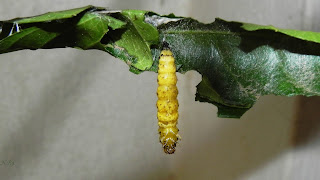Parotis marginata Hampson, 1893
The moth caterpillars are colourless to pale green with an yellow to orange head and black spots all over the body. In this batch there were around 12 caterpillars observed attaining later instars.
The caterpillars are observed feeding on both varieties of Crape Jasmine - Tabernaemontana divaricata : 'Flore Pleno' & 'Pinwheel'. There are also records of other host plants where they are seen feeding on.
Pinwheel Flore Pleno
The caterpillars are seen to co-exist with ants (yellow crazy ants [Anoplolepis gracilipes] in this case). No mutual relationship noticed.
Early stage caterpillars use one half of the leaf make a cell to stay in. They then eat from inside starting with the outer end of the leaf.
When grown, they use the entire leaf to make cells and eat from inside the cell starting from tip and working its way towards the leaf stalk (petiole). At times they are seen outside the cell feeding on leaves again from tip to stalk.
The caterpillars are also seen to feed on flowerbuds in earlier stages.
This video shows a P. marginata caterpillar constructing a cell.
The colour of the caterpillar slowly changes from pale green to yellowish when its about to pupate.
The caterpillar slowly turns into a pupae inside the cell. Shown below is an unusual behaviour where the pupation happened outside the cell. The pupa later fell down.
Pupation happens inside a fully closed cell.
Shown here is a pupa inside the cell in a protective cocoon.
Note: It is not recommended to open the cell. The below leaf fell from the plant, it was then taken in and kept until it eclosed. The chances for an adult to eclose is more when in the wild.
Pupa is dark brownish red in colour during its initial stages.
Only 8 caterpillars lived to pupate.
It turns darker when its about to eclose.
The adult after eclosing.... One shown below is a male. The hair pencils on the abdomen are seen here.
The adult is green in colour. The first pair of legs have two yellowish orange spots. The upper fore and hind wings have one black spot each.
Among the observed individuals, 60% were males.
All the pupae eclosed except for the one that pupated outside the cell and fell down.
Empty shell after the adult emerged.
The adult was immediately released after it eclosed.
The observation is made during Nov - Dec 2016 from South India.
To use the images / content kindly pm the author or leave a comment.



















